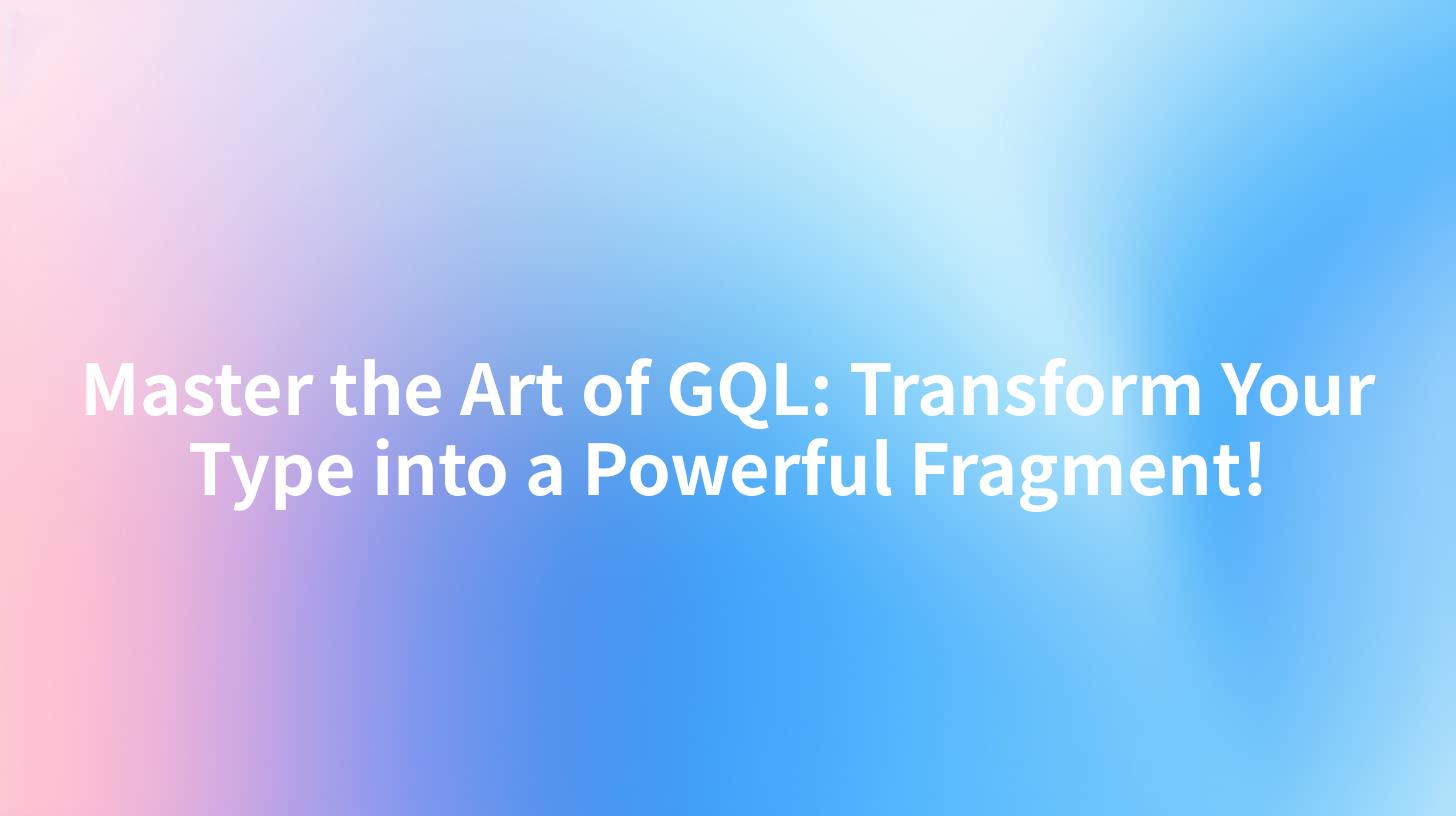Master the Art of GQL: Transform Your Type into a Powerful Fragment!

Open-Source AI Gateway & Developer Portal
Introduction
GraphQL, often referred to as GQL, has revolutionized the way developers interact with APIs. It provides a more efficient and flexible way to fetch data compared to traditional RESTful APIs. One of the key concepts in GraphQL is the fragment, which allows you to reuse query patterns. In this comprehensive guide, we will delve into the world of GQL, exploring its servers, fragments, and how you can leverage these concepts to transform your data into powerful fragments. We will also introduce APIPark, an open-source AI gateway and API management platform that can help streamline your GQL development process.
Understanding GraphQL Servers
Before we dive into fragments, it's crucial to understand GraphQL servers. A GraphQL server is responsible for handling client queries and returning the requested data. It is built using a GraphQL schema, which defines the types and operations available to the client. The server processes the client's query and returns a JSON response containing the requested data.
Key Components of a GraphQL Server
Here are some of the key components of a GraphQL server:
- Schema: Defines the types, queries, mutations, and subscriptions available to the client.
- Resolvers: Functions that resolve the data for each field in the schema.
- Type System: Defines the data types that can be used in the schema, such as objects, strings, integers, etc.
- Validation: Ensures that the client's query adheres to the schema's rules.
Exploring Fragments in GQL
Now that we have a basic understanding of GraphQL servers, let's move on to fragments. Fragments are reusable pieces of a query that encapsulate a selection set. They allow you to define a query pattern that can be reused across different queries.
How Fragments Work
Fragments work by defining a selection set that can be included in multiple queries. This selection set is then applied to the relevant types in the schema. Fragments can be included in both queries and mutations.
Benefits of Using Fragments
Here are some of the benefits of using fragments in your GQL queries:
- Reusability: Fragments can be reused across different queries, reducing code duplication.
- Maintainability: By encapsulating common query patterns in fragments, you can make your code easier to maintain.
- Flexibility: Fragments allow you to apply the same selection set to multiple types, making your queries more flexible.
APIPark is a high-performance AI gateway that allows you to securely access the most comprehensive LLM APIs globally on the APIPark platform, including OpenAI, Anthropic, Mistral, Llama2, Google Gemini, and more.Try APIPark now! 👇👇👇
Transforming Your Type into a Powerful Fragment
Now that we understand the basics of GQL servers and fragments, let's explore how you can transform your data into a powerful fragment.
Step 1: Define Your Type
The first step is to define your type in the GraphQL schema. This type will represent the data you want to query and will contain fields that define the data structure.
Step 2: Create a Fragment
Next, create a fragment that encapsulates the selection set you want to reuse. This fragment can be applied to the type you defined in the previous step.
Step 3: Use the Fragment in Your Query
Finally, use the fragment in your query by including it in the selection set. This will apply the fragment's selection set to the type, allowing you to fetch the data you need.
APIPark: Streamlining Your GQL Development
APIPark is an open-source AI gateway and API management platform that can help streamline your GQL development process. It offers a variety of features that can help you manage your GraphQL server, including schema management, query validation, and more.
Key Features of APIPark
Here are some of the key features of APIPark:
- Schema Management: Allows you to define and manage your GraphQL schema.
- Query Validation: Ensures that client queries adhere to the schema's rules.
- API Gateway: Provides a central point for managing and routing API requests.
- Monitoring: Tracks the performance of your GraphQL server and provides insights into query patterns.
How APIPark Can Help with GQL Fragments
APIPark can help you manage your GQL fragments by providing a centralized location for defining and storing them. This can make it easier to reuse fragments across different queries and maintain your codebase.
Conclusion
Mastering the art of GQL and leveraging fragments can greatly enhance the efficiency and flexibility of your data fetching operations. By understanding GraphQL servers, fragments, and using tools like APIPark, you can transform your data into powerful fragments and streamline your GQL development process.
FAQs
Q1: What is a GraphQL server? A1: A GraphQL server is a backend system that processes GraphQL queries from clients and returns the requested data in a JSON format.
Q2: What are fragments in GQL? A2: Fragments in GQL are reusable pieces of a query that encapsulate a selection set. They allow you to define a query pattern that can be reused across different queries.
**Q3: How can I use fragments to transform my data into
🚀You can securely and efficiently call the OpenAI API on APIPark in just two steps:
Step 1: Deploy the APIPark AI gateway in 5 minutes.
APIPark is developed based on Golang, offering strong product performance and low development and maintenance costs. You can deploy APIPark with a single command line.
curl -sSO https://download.apipark.com/install/quick-start.sh; bash quick-start.sh

In my experience, you can see the successful deployment interface within 5 to 10 minutes. Then, you can log in to APIPark using your account.

Step 2: Call the OpenAI API.
